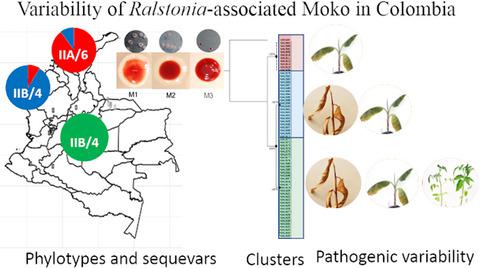当前位置:
X-MOL 学术
›
Plant Pathol.
›
论文详情
Our official English website, www.x-mol.net, welcomes your feedback! (Note: you will need to create a separate account there.)
Phylogenetic and pathogenic variability of strains of Ralstonia solanacearum causing moko disease in Colombia
Plant Pathology ( IF 2.7 ) Pub Date : 2019-12-18 , DOI: 10.1111/ppa.13121 M. Ramírez 1 , R. N. Moncada 2 , V. Villegas‐Escobar 2 , R. W. Jackson 3 , C. A. Ramírez 1
Plant Pathology ( IF 2.7 ) Pub Date : 2019-12-18 , DOI: 10.1111/ppa.13121 M. Ramírez 1 , R. N. Moncada 2 , V. Villegas‐Escobar 2 , R. W. Jackson 3 , C. A. Ramírez 1
Affiliation

|
Moko disease, caused by the bacterium Ralstonia solanacearum, is one of the most devastating diseases of Musa spp. in Colombia, where banana and plantain are major crops. The disease epidemiology is poorly understood and little is known about the diversity of the bacterial populations associated with this disease. This study assessed the diversity, phylogenetic relationship and pathogenicity of R. solanacearum strains associated with moko disease in Colombia. For this, the genetic diversity of 65 isolates obtained from four banana/plantain‐growing regions was evaluated by using multiplex PCR and analysing the partial sequences of the mutS, rplB and egl genes. These analyses revealed that all the strains belonged to the R. solanacearum phylotype II, sequevars 4 and 6. In addition, the phylogenetic analysis assorted the strains into three subgroups, which matched the region of isolation: (i) central region (i.e. Eastern plains and Andes, IIB/4); (ii) northwest (i.e. Uraba and a few strains from Magdalena, IIB/4); and (iii) north coast (Magdalena and a few strains from Uraba, IIA/6). In addition, this evolutionary pattern was associated with pathogenicity, as 63 of the 65 isolates caused wilting of banana and plantain plants under greenhouse conditions, whilst only 32, those isolated from the central region, caused such symptoms in tomato plants. In conclusion, this study shows that banana and plantain crops in Colombia foster genetically diverse strains of R. solanacearum that belong to at least three different genetic groups, which show biogeographic and host range association.
中文翻译:

哥伦比亚引起莫科病的青枯病菌菌株的系统发育和致病变异
由青枯病菌引起的莫科病是Musa spp 最具破坏性的疾病之一。在哥伦比亚,香蕉和大蕉是主要作物。人们对该疾病的流行病学知之甚少,对与该疾病相关的细菌种群的多样性知之甚少。本研究评估了哥伦比亚与莫科病相关的青枯菌菌株的多样性、系统发育关系和致病性。为此,通过使用多重 PCR 并分析 mutS、rplB 和 egl 基因的部分序列,评估了从四个香蕉/大蕉种植区获得的 65 个分离株的遗传多样性。这些分析表明,所有菌株都属于青枯菌系统发育型 II、序列变体 4 和 6。此外,系统发育分析将菌株分为三个亚组,与隔离区相匹配的地区:(i) 中部地区(即东部平原和安第斯山脉,IIB/4);(ii) 西北部(即 Uraba 和来自 Magdalena 的一些菌株,IIB/4);(iii) 北海岸(Magdalena 和来自 Uraba 的一些菌株,IIA/6)。此外,这种进化模式与致病性有关,因为 65 种分离株中有 63 种在温室条件下导致香蕉和大蕉植物枯萎,而只有 32 种分离自中部地区的分离株导致番茄植物出现此类症状。总之,这项研究表明,哥伦比亚的香蕉和大蕉作物培育了属于至少三个不同遗传组的青枯菌遗传多样性菌株,这些菌株显示出生物地理和宿主范围关联。e. Uraba 和一些来自 Magdalena 的菌株,IIB/4);(iii) 北海岸(Magdalena 和来自 Uraba 的一些菌株,IIA/6)。此外,这种进化模式与致病性有关,因为 65 种分离株中有 63 种在温室条件下导致香蕉和大蕉植物枯萎,而只有 32 种分离自中部地区的分离株导致番茄植物出现此类症状。总之,这项研究表明,哥伦比亚的香蕉和大蕉作物培育了属于至少三个不同遗传组的青枯菌遗传多样性菌株,这些菌株显示出生物地理和宿主范围关联。e. Uraba 和一些来自 Magdalena 的菌株,IIB/4);(iii) 北海岸(Magdalena 和来自 Uraba 的一些菌株,IIA/6)。此外,这种进化模式与致病性有关,因为 65 种分离株中有 63 种在温室条件下导致香蕉和大蕉植物枯萎,而只有 32 种分离自中部地区的分离株导致番茄植物出现此类症状。总之,这项研究表明,哥伦比亚的香蕉和大蕉作物培育了属于至少三个不同遗传组的青枯菌遗传多样性菌株,这些菌株显示出生物地理和宿主范围关联。因为在 65 种分离株中,有 63 种导致温室条件下香蕉和大蕉植物枯萎,而只有 32 种分离自中部地区的分离株导致番茄植物出现此类症状。总之,这项研究表明,哥伦比亚的香蕉和大蕉作物培育了属于至少三个不同遗传组的青枯菌遗传多样性菌株,这些菌株显示出生物地理和宿主范围关联。因为在 65 种分离株中,有 63 种导致温室条件下香蕉和大蕉植物枯萎,而只有 32 种分离自中部地区的分离株导致番茄植物出现此类症状。总之,这项研究表明,哥伦比亚的香蕉和大蕉作物培育了属于至少三个不同遗传组的青枯菌遗传多样性菌株,这些菌株显示出生物地理和宿主范围关联。
更新日期:2019-12-18
中文翻译:

哥伦比亚引起莫科病的青枯病菌菌株的系统发育和致病变异
由青枯病菌引起的莫科病是Musa spp 最具破坏性的疾病之一。在哥伦比亚,香蕉和大蕉是主要作物。人们对该疾病的流行病学知之甚少,对与该疾病相关的细菌种群的多样性知之甚少。本研究评估了哥伦比亚与莫科病相关的青枯菌菌株的多样性、系统发育关系和致病性。为此,通过使用多重 PCR 并分析 mutS、rplB 和 egl 基因的部分序列,评估了从四个香蕉/大蕉种植区获得的 65 个分离株的遗传多样性。这些分析表明,所有菌株都属于青枯菌系统发育型 II、序列变体 4 和 6。此外,系统发育分析将菌株分为三个亚组,与隔离区相匹配的地区:(i) 中部地区(即东部平原和安第斯山脉,IIB/4);(ii) 西北部(即 Uraba 和来自 Magdalena 的一些菌株,IIB/4);(iii) 北海岸(Magdalena 和来自 Uraba 的一些菌株,IIA/6)。此外,这种进化模式与致病性有关,因为 65 种分离株中有 63 种在温室条件下导致香蕉和大蕉植物枯萎,而只有 32 种分离自中部地区的分离株导致番茄植物出现此类症状。总之,这项研究表明,哥伦比亚的香蕉和大蕉作物培育了属于至少三个不同遗传组的青枯菌遗传多样性菌株,这些菌株显示出生物地理和宿主范围关联。e. Uraba 和一些来自 Magdalena 的菌株,IIB/4);(iii) 北海岸(Magdalena 和来自 Uraba 的一些菌株,IIA/6)。此外,这种进化模式与致病性有关,因为 65 种分离株中有 63 种在温室条件下导致香蕉和大蕉植物枯萎,而只有 32 种分离自中部地区的分离株导致番茄植物出现此类症状。总之,这项研究表明,哥伦比亚的香蕉和大蕉作物培育了属于至少三个不同遗传组的青枯菌遗传多样性菌株,这些菌株显示出生物地理和宿主范围关联。e. Uraba 和一些来自 Magdalena 的菌株,IIB/4);(iii) 北海岸(Magdalena 和来自 Uraba 的一些菌株,IIA/6)。此外,这种进化模式与致病性有关,因为 65 种分离株中有 63 种在温室条件下导致香蕉和大蕉植物枯萎,而只有 32 种分离自中部地区的分离株导致番茄植物出现此类症状。总之,这项研究表明,哥伦比亚的香蕉和大蕉作物培育了属于至少三个不同遗传组的青枯菌遗传多样性菌株,这些菌株显示出生物地理和宿主范围关联。因为在 65 种分离株中,有 63 种导致温室条件下香蕉和大蕉植物枯萎,而只有 32 种分离自中部地区的分离株导致番茄植物出现此类症状。总之,这项研究表明,哥伦比亚的香蕉和大蕉作物培育了属于至少三个不同遗传组的青枯菌遗传多样性菌株,这些菌株显示出生物地理和宿主范围关联。因为在 65 种分离株中,有 63 种导致温室条件下香蕉和大蕉植物枯萎,而只有 32 种分离自中部地区的分离株导致番茄植物出现此类症状。总之,这项研究表明,哥伦比亚的香蕉和大蕉作物培育了属于至少三个不同遗传组的青枯菌遗传多样性菌株,这些菌株显示出生物地理和宿主范围关联。


























 京公网安备 11010802027423号
京公网安备 11010802027423号